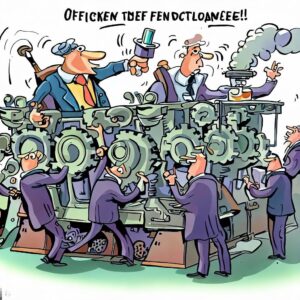In this article, we will explore ten ways to improve production efficiency. By implementing these methods, businesses can streamline their operations, reduce waste, and enhance overall productivity. Efficient production processes are crucial for businesses to maximize productivity and maintain a competitive edge.
1. Implement Lean Manufacturing Principles
Lean manufacturing is a systematic approach that strives to eliminate waste and optimize production processes. By identifying and eliminating non-value-added activities, businesses can significantly reduce costs, enhance product quality, and improve overall efficiency. The adoption of lean manufacturing principles has proven to be a game-changer for numerous organizations across industries.
One valuable resource for businesses looking to implement lean manufacturing principles is the Lean Enterprise Institute (lean.org). The institute offers a wealth of knowledge, including research papers, case studies, and practical tools to guide businesses in their lean journey. By leveraging the expertise and insights provided by the Lean Enterprise Institute, organizations can gain a deeper understanding of lean concepts and learn from successful implementation stories.
Lean manufacturing focuses on streamlining operations by identifying and eliminating various types of waste, such as overproduction, excess inventory, unnecessary motion, defects, and waiting time. By eliminating these wasteful activities, businesses can optimize their production processes, reduce lead times, and improve customer satisfaction.
Furthermore, lean manufacturing emphasizes continuous improvement and employee engagement. It encourages organizations to empower their employees to identify and solve problems, fostering a culture of innovation and collaboration. By involving employees at all levels, businesses can tap into their knowledge and experience to drive meaningful improvements and achieve sustainable results.
Implementing lean manufacturing principles can bring about significant benefits for businesses, including cost reduction, improved quality, and enhanced efficiency. The Lean Enterprise Institute (lean.org) serves as an invaluable resource for organizations embarking on their lean journey, providing the necessary guidance and support to achieve successful implementation. By embracing lean manufacturing principles and fostering a culture of continuous improvement, businesses can position themselves for long-term success in today’s competitive market.

2. Invest in Automation and Technology
The integration of automation and technology into production processes has the potential to revolutionize efficiency. By automating repetitive tasks, businesses can minimize errors, boost output, and reduce labor costs. Embracing the latest technological advancements can be a game-changer for organizations seeking to stay competitive in the evolving manufacturing landscape.
For valuable insights into the latest technological advancements and their application in manufacturing, the National Institute of Standards and Technology (nist.gov) serves as an invaluable resource. This reputable institution provides a wealth of knowledge, research, and case studies that can guide businesses in their journey towards leveraging automation and technology effectively.
Automation plays a pivotal role in streamlining operations and eliminating bottlenecks. By automating routine and repetitive tasks, businesses can free up their workforce to focus on more complex and value-added activities. This not only reduces the risk of errors but also increases productivity and enables organizations to meet growing demands efficiently.
Furthermore, investing in technology enables businesses to embrace innovative solutions such as robotics, artificial intelligence, and data analytics. These cutting-edge technologies have the potential to optimize processes, improve decision-making, and enhance overall operational performance. By harnessing the power of technology, organizations can gain a competitive edge, adapt to market changes swiftly, and deliver products and services of the highest quality.
It is important for businesses to stay abreast of the latest advancements in automation and technology to make informed investment decisions. By leveraging the expertise and resources provided by institutions like the National Institute of Standards and Technology, organizations can navigate the rapidly evolving technological landscape and identify the most suitable solutions for their specific needs.
Investing in automation and technology is a strategic move that can significantly enhance efficiency and competitiveness. The National Institute of Standards and Technology offers a wealth of knowledge and insights to guide businesses in their adoption of the latest technological advancements. By embracing automation and technology, organizations can unlock new levels of productivity, improve decision-making, and position themselves for success in the digital age.

3. Optimize Supply Chain Management
Efficient supply chain management plays a pivotal role in ensuring the seamless operation of production processes. By focusing on improving communication and collaboration with suppliers, businesses can unlock a multitude of benefits, including minimized lead times, reduced inventory levels, and enhanced overall productivity.
To gain valuable insights into supply chain management best practices, the Massachusetts Institute of Technology (mit.edu) serves as an exceptional resource. This prestigious institution offers a wealth of research, resources, and case studies that can guide businesses in optimizing their supply chain operations.
Effective communication and collaboration with suppliers are key factors in streamlining the flow of materials and information throughout the supply chain. By establishing strong relationships and open lines of communication, businesses can reduce lead times, ensure timely deliveries, and proactively address any potential issues that may arise. This not only enhances operational efficiency but also improves customer satisfaction by meeting delivery deadlines and minimizing disruptions.
Furthermore, a well-optimized supply chain enables businesses to minimize inventory levels while maintaining adequate stock to meet customer demands. By implementing efficient inventory management techniques, such as just-in-time (JIT) or vendor-managed inventory (VMI), organizations can reduce carrying costs, minimize the risk of obsolescence, and free up valuable resources.
The Massachusetts Institute of Technology offers a wealth of research and resources on supply chain management, covering topics ranging from demand forecasting and inventory optimization to logistics and transportation. By leveraging these insights, businesses can gain a competitive edge by implementing industry best practices and staying ahead of the curve.
Optimizing supply chain management is crucial for the smooth operation of production processes. By improving communication and collaboration with suppliers and leveraging the resources provided by institutions like the Massachusetts Institute of Technology, businesses can minimize lead times, reduce inventory levels, and enhance overall productivity. A well-optimized supply chain not only improves operational efficiency but also contributes to customer satisfaction and long-term success.

4. Implement Continuous Improvement Programs
The implementation of continuous improvement programs, such as Six Sigma and Kaizen, holds immense potential for identifying and eliminating process inefficiencies within a business. These programs emphasize the importance of employee involvement and foster a culture of continuous improvement, ultimately driving innovation, enhancing quality, and boosting overall productivity.
To gain valuable insights and resources on continuous improvement methodologies, the American Society for Quality (asq.org) serves as an exceptional source. This reputable organization provides a wealth of information, tools, and case studies that can guide businesses in implementing effective continuous improvement initiatives.
Continuous improvement programs empower employees at all levels to actively participate in the identification and resolution of process inefficiencies. By encouraging a culture of open communication, collaboration, and learning, businesses can tap into the collective knowledge and creativity of their workforce. This not only leads to the identification of improvement opportunities but also fosters innovation and a sense of ownership among employees.
Furthermore, continuous improvement programs provide structured methodologies and tools that enable businesses to analyze and optimize their processes. Six Sigma, for instance, focuses on reducing process variation and defects, while Kaizen emphasizes small, incremental improvements. By implementing these methodologies, organizations can enhance the quality of their products or services, streamline operations, and ultimately deliver greater value to customers.
The American Society for Quality offers a wide range of resources on continuous improvement, covering topics such as Lean Six Sigma, process improvement techniques, and quality management systems. By leveraging these resources, businesses can gain the necessary knowledge and guidance to implement effective continuous improvement programs tailored to their specific needs.
Implementing continuous improvement programs is crucial for identifying and eliminating process inefficiencies. By fostering a culture of continuous improvement and employee involvement, businesses can drive innovation, enhance quality, and boost productivity. The American Society for Quality provides valuable resources that can guide organizations in implementing successful continuous improvement initiatives, ultimately leading to long-term success and competitive advantage.

5. Train and Empower Employees
The significance of well-trained and empowered employees cannot be overstated when it comes to improving production efficiency. By offering comprehensive training programs and empowering employees to make informed decisions, businesses can effectively enhance skill sets, minimize errors, and maximize overall efficiency.
To gain valuable insights into effective employee training and development strategies, the Society for Human Resource Management (shrm.org) serves as an invaluable resource. This reputable organization provides a wealth of knowledge, research, and best practices that can guide businesses in implementing impactful employee training initiatives.
Comprehensive training programs play a pivotal role in equipping employees with the necessary knowledge and skills to perform their roles effectively. By providing structured training sessions, workshops, and online resources, businesses can ensure that employees have a solid foundation and a clear understanding of their responsibilities. This not only reduces the likelihood of errors but also boosts confidence and job satisfaction, leading to improved productivity.
Empowering employees to make decisions within their areas of expertise is equally important. By delegating authority and fostering a culture of trust, businesses enable employees to take ownership of their work and contribute innovative ideas. This not only enhances motivation and engagement but also leads to more efficient problem-solving and decision-making processes.
The Society for Human Resource Management offers valuable insights into effective employee training and development strategies, covering topics such as onboarding, skills development, and performance management. By leveraging these resources, businesses can design and implement tailored training programs that align with their organizational goals and meet the specific needs of their workforce.
Training and empowering employees are essential steps toward improving production efficiency. By providing comprehensive training programs and empowering employees to make decisions, businesses can enhance skill sets, minimize errors, and increase overall efficiency. The Society for Human Resource Management offers valuable resources that can guide organizations in implementing effective employee training and development strategies, ultimately leading to a more productive and engaged workforce.

6. Optimize Workflows and Layouts
Analyzing and optimizing workflows and layouts holds immense potential for improving production efficiency. By identifying and eliminating bottlenecks, as well as optimizing the flow of materials and information, businesses can effectively minimize delays, reduce waste, and increase overall throughput.
To gain valuable guidelines on optimizing workplace layouts, the National Institute for Occupational Safety and Health (NIOSH) serves as a reputable resource. This esteemed organization provides comprehensive insights and recommendations that can guide businesses in optimizing their workflows and layouts to enhance efficiency.
Analyzing workflows involves mapping out the sequence of tasks and processes involved in production. This helps identify any inefficiencies, redundancies, or bottlenecks that may hinder the smooth flow of work. By streamlining and reorganizing these workflows, businesses can eliminate unnecessary steps, optimize task allocation, and improve overall productivity.
Layout optimization focuses on the physical arrangement of equipment, workstations, and resources within the production facility. By strategically placing machinery, tools, and materials in a logical and efficient manner, businesses can minimize unnecessary movement, reduce transportation time, and enhance worker productivity. This includes considerations such as ergonomics, safety, and accessibility.
The National Institute for Occupational Safety and Health offers valuable guidelines on optimizing workplace layouts, covering aspects such as space utilization, workflow design, and ergonomic considerations. By leveraging these guidelines, businesses can make informed decisions to create layouts that maximize efficiency, safety, and overall productivity.
Optimizing workflows and layouts is crucial for enhancing production efficiency. By eliminating bottlenecks and optimizing the flow of materials and information, businesses can minimize delays, reduce waste, and increase overall throughput. The National Institute for Occupational Safety and Health provides valuable guidelines that can guide organizations in optimizing their workplace layouts, ultimately leading to improved efficiency and a more streamlined production process.

7. Implement Energy Efficiency Measures
The implementation of energy efficiency measures holds tremendous potential for improving both production efficiency and environmental sustainability. By adopting energy-efficient technologies and practices, businesses can not only reduce their environmental impact but also lower operational costs and enhance overall efficiency.
To gain valuable insights and resources on energy-saving practices for businesses, the U.S. Department of Energy (DOE) serves as a reliable source. This esteemed organization offers a wealth of information and guidance to help businesses implement effective energy efficiency measures.
Implementing energy-efficient technologies and practices involves a multifaceted approach. Businesses can start by conducting energy audits to identify areas of high consumption and potential energy-saving opportunities. This allows for targeted improvements and the implementation of energy-efficient solutions, such as upgrading to energy-efficient lighting systems, optimizing HVAC systems, and utilizing energy management systems.
Additionally, businesses can adopt practices that promote energy conservation and awareness among employees. This includes implementing energy-saving policies, conducting employee training on energy efficiency, and encouraging behavioral changes, such as turning off equipment when not in use or optimizing production schedules to take advantage of off-peak energy rates.
By implementing energy efficiency measures, businesses can achieve multiple benefits. Firstly, they can reduce operational costs by lowering energy consumption and minimizing waste. Secondly, they can enhance sustainability by reducing greenhouse gas emissions and conserving natural resources. Lastly, energy efficiency measures can also improve production efficiency by optimizing energy usage and minimizing downtime.
Implementing energy efficiency measures is a crucial step towards enhancing production efficiency. By adopting energy-efficient technologies and practices, businesses can lower operational costs, improve sustainability, and optimize energy usage. The U.S. Department of Energy offers valuable resources that can guide organizations in implementing effective energy-saving practices, ultimately leading to a more efficient and environmentally conscious production process.

8. Foster a Culture of Accountability
Establishing a culture of accountability plays a pivotal role in driving production efficiency within businesses. By setting clear performance expectations, defining measurable metrics, and holding employees accountable for their actions, organizations can foster a productive work environment that encourages continuous improvement and enhances overall efficiency.
To gain valuable insights into fostering a culture of accountability, the Harvard Business Review (HBR) serves as a reputable resource. This esteemed publication offers a wealth of knowledge and research on organizational practices that promote accountability.
Creating a culture of accountability starts with setting clear performance expectations. By clearly defining goals, objectives, and key performance indicators (KPIs), businesses provide employees with a clear understanding of what is expected of them. This clarity helps align individual efforts with organizational objectives and ensures everyone is working towards a common goal.
In addition to setting expectations, it is essential to establish measurable metrics to track performance and progress. By implementing performance measurement systems, such as balanced scorecards or key result areas (KRAs), businesses can objectively assess individual and team performance, identify areas for improvement, and make data-driven decisions to enhance efficiency.
Holding employees accountable for their actions is another critical aspect of fostering a culture of accountability. This involves providing timely feedback, recognizing achievements, and addressing performance gaps. By promoting a sense of ownership and responsibility, businesses empower employees to take ownership of their work, make informed decisions, and continuously strive for improvement.
Furthermore, fostering a culture of accountability requires leadership commitment and role modeling. Leaders should exemplify accountability by demonstrating transparency, taking responsibility for their actions, and holding themselves to high standards. When employees see leaders embodying accountability, it sets a positive example and encourages others to follow suit.
Fostering a culture of accountability is vital for driving production efficiency. By setting clear performance expectations, establishing measurable metrics, and holding employees accountable, businesses can promote productivity, continuous improvement, and a sense of ownership. The Harvard Business Review provides valuable insights that can guide organizations in cultivating a culture of accountability, ultimately leading to enhanced efficiency and organizational success.

9. Conduct Regular Performance Analysis
Regularly analyzing production performance is a critical practice for businesses aiming to identify areas of improvement and optimize their operations. By collecting and meticulously analyzing relevant data, organizations can uncover bottlenecks, inefficiencies, and valuable opportunities for enhancing efficiency and overall performance.
To gain valuable guidelines on performance measurement and analysis, the National Institute of Standards and Technology (NIST) stands as a reliable source. This esteemed institution offers a wealth of resources and expertise to assist businesses in effectively measuring and analyzing their performance.
Conducting regular performance analysis involves a systematic approach. Businesses should start by identifying key performance indicators (KPIs) that align with their strategic goals and objectives. These KPIs can encompass various aspects of production, such as productivity, quality, cycle time, and customer satisfaction. By selecting the most relevant and meaningful metrics, organizations can focus their analysis on areas that have the greatest potential for improvement.
Once the KPIs are established, businesses need to collect and analyze data to evaluate their performance against these indicators. This can involve gathering data from various sources, such as production systems, quality control processes, and customer feedback. By utilizing data analysis techniques, such as statistical analysis, data visualization, and trend analysis, businesses can gain valuable insights into their performance and uncover patterns or anomalies that require attention.
Based on the findings, businesses can identify areas of improvement and develop targeted strategies and action plans. This can involve implementing process optimization initiatives, investing in training and development programs, or making necessary adjustments to equipment or workflows. Regular performance analysis enables organizations to make informed decisions and allocate resources effectively to drive continuous improvement and enhance production efficiency.
Furthermore, it is crucial to establish a feedback loop and monitor the impact of improvement initiatives. By regularly reassessing performance and comparing it against previous benchmarks, businesses can evaluate the effectiveness of implemented changes and make further adjustments as needed.
Conducting regular performance analysis is an essential practice for businesses seeking to improve production efficiency. By collecting and analyzing relevant data, organizations can identify areas of improvement, address bottlenecks, and uncover valuable opportunities for optimization. The National Institute of Standards and Technology provides valuable guidelines that can assist businesses in effectively measuring and analyzing their performance. By embracing this practice, organizations can drive continuous improvement, enhance efficiency, and achieve long-term success in their production processes.

10. Implement Quality Management Systems
To enhance production efficiency, businesses can implement robust quality management systems, such as ISO 9001. By adopting these systems, organizations can standardize processes, monitor quality, and continuously improve operations, resulting in increased productivity and heightened customer satisfaction. The International Organization for Standardization (ISO) serves as a valuable resource, offering comprehensive information on quality management systems.
Implementing a quality management system entails establishing a set of standardized processes and procedures that govern every aspect of production. This systematic approach ensures consistency, reduces errors, and minimizes waste, leading to improved efficiency. By clearly defining roles, responsibilities, and workflows, businesses can streamline operations and eliminate unnecessary steps or redundancies.
Monitoring and maintaining quality are integral components of an effective quality management system. Regular inspections, quality control checks, and performance evaluations help identify deviations from established standards and enable timely corrective actions. By proactively addressing quality issues, businesses can prevent defects, reduce rework, and enhance overall product quality.
Continuous improvement is a fundamental principle of quality management systems. By encouraging a culture of innovation and learning, organizations can foster an environment where employees actively seek opportunities to optimize processes and enhance efficiency. Regularly reviewing performance data, soliciting feedback from stakeholders, and implementing improvement initiatives are key elements of this approach.
ISO 9001, a globally recognized quality management standard, provides a framework for businesses to implement effective quality management systems. It offers guidelines and best practices that align with international standards, ensuring organizations adhere to rigorous quality requirements and meet customer expectations.
By implementing a robust quality management system, businesses can unlock numerous benefits. Enhanced customer satisfaction is achieved through consistent product quality, on-time delivery, and reliable service. Increased productivity is realized by minimizing errors, reducing waste, and optimizing processes. Furthermore, businesses gain a competitive edge by demonstrating their commitment to quality and continuous improvement.
Implementing a robust quality management system, such as ISO 9001, is a proven strategy for improving production efficiency. By standardizing processes, monitoring quality, and continuously improving operations, businesses can elevate customer satisfaction and increase productivity. The International Organization for Standardization (ISO) serves as a valuable resource, providing comprehensive information on quality management systems. Embracing a quality-focused approach enables organizations to drive excellence, achieve operational excellence, and thrive in today’s competitive business landscape.

Conclusion
Improving production efficiency is vital for businesses to remain competitive in today’s fast-paced market. By implementing the ten strategies outlined in this article, businesses can streamline operations, reduce waste, and enhance overall productivity. Remember to continuously monitor and evaluate performance to identify areas for further improvement. By embracing a culture of continuous improvement and leveraging the latest technologies and best practices, businesses can achieve sustainable production efficiency and drive long-term success.
